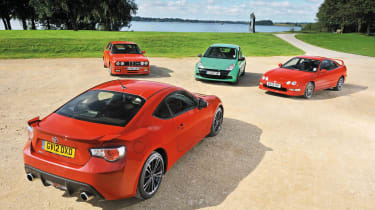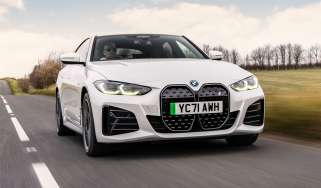Toyota GT86 vs Renault Clio Cup, Honda Integra Type-R and BMW M3
We pit the Toyota GT86 against icons with the same power to weight ratio: the Renault Clio 200 Cup, Honda Integra Type-R and BMW E30 M3
Power corrupts. So these four should be as pure as the driven snow. Less power and less weight is the route to motoring nirvana in the modern world according to the people behind the Toyota GT86 – and we fundamentally agree. Although we’ve been accused of not really getting the whole ethos behind the GT86/BRZ mash-up (after our gentle suggestion that it would be more fun if it had a little bit of light-pressure turbocharging under the bonnet) we do essentially like what the GT86 stands for. And to prove that we like cars of its ilk, to meet the newcomer we have lined up three of our favourites that play by the 86’s rules. All adhere to the same sort of performance parameters as the Toyota, with no more than 200bhp and tipping the scales between 1100 and 1200kg (OK, 1204kg to be precise). First up we have the greatest M-car ever produced, the BMW E30 M3. With 197bhp at 7000rpm in this non-Evolution form, it is a spot-on power match for the Toyota, although a 35kg weight saving and a 25lb ft torque advantage do play in the older car’s favour. Next is the no-less-iconic Honda Integra Type-R (DC2), which was proclaimed ‘the greatest front-wheel-drive car ever’ in these pages a few years ago (evo 095). Giving away 10bhp and 20lb ft to the Toyota it is the least gutsy car of the four, but it is also the lightest, barely troubling the weighbridge at just 1101kg. Completing our quartet is the car that is, on paper, so close to the GT86 that if they both joined a dating site they’d be matched up and married with twins inside a year. Not only does the Renaultsport Clio 200 Cup have a power-to-weight ratio just 1bhp/ton lower (166 plays 167) and an identical swept volume in its four cylinders, it also has exactly the same tyre size of 215/45 R17. I’m heading towards the smallest county in England today, Rutland. It’s quite a pleasantly meandering journey across country to get there too, and the almost supercar-low view out of the GT86’s windscreen is a good one. Your hips seem to be set down low in the chassis, rather like in an Elise, and your legs are stretched out straighter than normal under the nice small-diameter wheel in front of you. The manual gearbox is a pleasure too, the lever not far from the wheel and the actual shift around the six-speed gate a light, tight positive one. Above all else, the GT86 is a compact-feeling car, one that is easy to thread down a lane or between traffic. Our first muster point for the day is at the watery heart of Rutland next to the huge artificial reservoir. Weirdly, it’s the jolly green giant of a Clio that looks the biggest of all the cars when they’re parked up together. The M3 with its box ’arches just looks ace, but there’s something about the narrow, low-slung proportions of the Integra that give it a very similar stance to the GT86, despite it being pulled from the front rather than pushed from the rear. The Clio’s number plate is either genius or heinous depending on your view of personalised registrations, but there is no doubting the quality of what’s attached to it. You sit markedly high up after getting out of the Toyota and you definitely reach down rather than across to the long gearlever. But as soon as you set off it is an instantly insatiable bundle of fun. The red needle on the yellow rev counter wants to be permanently on an upward sweep and the gearshift just encourages you to snatch each change as fast as you can move your hand. With feel right from the top of the pedal, the Brembo brakes are almost disproportionately powerful compared to the engine, but their ability to stand the Renault on its nose is addictive. Bumps and dips all make themselves known through the Clio’s chassis, and down a typical minor road the firm (but not crashy) ride means the car is permanently fidgeting like a child on a lethal mixture of Haribo and Red Bull. Any input to the wheel has the rim instantly weighting up and your forearms tensing a little in response. Dart left, the sidewalls of the front tyres eagerly take some load. Dart right, the load switches. Lift off, the outside rear tyre digs in and if you’ve got a lot of speed you can just feel the inside rear unload for a second and hang above the tarmac. Largely because of its more performance orientated tyres, it paints a sharper, busier, more vivid picture than the Toyota as it travels down the road, willing you to pick off every last millimetre of tarmac through a corner. It also clings on harder; on the limit, where the treadblocks of the Toyota’s Michelin Primacy HPs simply fold, there’s a feeling of defiant tenacity to the Clio as its ContiSportContact3s merely scrub instead of really slide. We decide to head down towards the Welland Viaduct next as it’s too spectacular not to use as a backdrop for a photo. Robin Archer kindly lets me jump back a couple of decades in his wonderfully original E30 M3 (a scant 89,000km on the odometer) for the drive there. Settling into the grey check seats the driving position is, as in the Clio, more upright than in the Toyota and you instantly notice the slight offset of the pedals in relation to the seat and wheel. Even after you’ve got past the dog-leg first, the gearshift of the Getrag ’box is still one that you instinctively take a little more time and care over than in the modern cars, easing it through the almost treacly last couple of centimetres of the throw. The elderly brakes too need a little more respect (but then it is a BMW). Although it has been said before, it’s worth repeating that much of the time the E30 can feel more like a beautifully set-up front-wheel-drive car than a rear-driver. Like the GT86, there simply isn’t the grunt to overcome the grip of the rear tyres with the throttle alone, and you tend to focus on the grip at the front end more than the rear. However, although that will sound like a monumental let-down to some, the beguiling thing about the E30 M3 is that it doesn’t need to be coaxed to extreme angles to be utterly absorbing. Take either of the corners that we used for the photos for example. If you’ve just hopped out of the Clio or Toyota then there’s what feels like an alarming amount of roll in the BMW as you turn in, and the steering seems very slow. So the next time through you recalculate and put a bit more effort into the initial part of the corner, so the car transfers through the roll and leans on to its spring more quickly. Once you’ve got it loaded up you seem to be telepathically linked to the front tyre that’s taking most of the strain, and you have options because you can feel how it’s moving around and what every little adjustment with the throttle or steering does. Carry the speed, stay committed and as you drive through the corner you can sense the lateral G-force on the chassis transition through the car, flowing from in front of your feet to somewhere by the boot. It’s a truly wonderful feeling. I think it’s fair to say that this is a test where interior design comes low on the list of our four cars’ priorities. None of them has a dashboard that is going to delight Kirstie Allsopp or a door pocket that would make Kevin McCloud swoon (which is something to be grateful for at least). But even amongst such interior mediocrity, the black plastic living space of a ’90s Honda is a potentially dreadful environment to find yourself in. And yet… the Integra feels perfect. The black leather of the steering wheel has been polished and smoothed by the palms of drivers’ hands so it gleams like a squaddie’s toecaps. The seat bolster nearest the door is wearing the miles too, slightly crumpled and deflated over the years by the thousands of entries and exits. The sickly sweet smell of a petrol-station Magic Tree lingers in your nostrils. But your hands sit perfectly on that Momo wheel and you’re hugged snugly by the low Recaro seat (particularly around the thighs). The crowning glory is the dull grey metal gearknob. Not just any old metal, of course, but titanium. It’s the equivalent of a crumby student flat being exactly as you’d expect except for a Chippendale sofa and a Rubens on the wall. Pottering along without the VTEC on song, the driving experience is somewhat prosaic to begin with. It doesn’t egg you on like the Clio and the gearshift feels much more spindly and vague than the Toyota’s. There is also an almost un-sporty suppleness to the suspension that is certainly closer in sensation to the older M3 than either of the current cars. You know that it’s supposed to be brilliant, but initially there’s a voice in the back of your head saying, ‘What’s all the fuss about?’ And then you increase the pace over some invisible threshold, the springs and dampers compress a little more and the steering suddenly seems to come alive in your hands. Initially, because the wheel is telling you so much, it’s easy to assume that you’ve arrived at the limit of the grip of the diminutive 15-inch front tyres. But you haven’t. Carry more speed into corners and the Integra somehow responds, drawing you in as it floods back information both textural and weighted through the wheel. The pedals are communicative too and the brakes are surprisingly strong (despite the rust-covered calipers!). At first your focus is entirely on the front end through a series of bends, but as you push harder, so the rear wheels come into play, instinctively helping your line through a corner. The limited-slip diff isn’t aggressive like on a modern Mégane, instead it just tames the front wheels and stops them from getting scrappy. Push really hard and the rear will even swing wide if you lift off, but you couldn’t ask for more friendly and controllable front-wheel-drive oversteer. It really is magic and it makes you want to keep driving until the fuel light comes on. Hopping back behind the wheel of the GT86 it certainly doesn’t feel slow after the others, and because you’re dialled into using all of the available revs in a gear, you never get lazy with your heel and toeing or caught out with the boxer struggling to wind up out of a corner. It’s in the corners, though, that it doesn’t shine quite so brightly as the others. The balance is great and there’s adjustment to be had, but because of the tyres the steering actually gets less feelsome at the limit (which still feels very high compared to the others here thanks to that brilliantly engineered chassis), so you rely on instinct more, which naturally limits where you feel comfortable pushing the car hard. Carry speed, flick it in with the quick steering, lift off the throttle just as the nose loses traction so that the front tyres regain grip and the back ones lose it, reapply the throttle, catch the slide and smile. It’s great fun, but the opportunities to do it are few and far between. So where does all this leave the GT86? Well, in this company, it isn’t outclassed in terms of performance and although it doesn’t have the brightest of engines, none of the others’ powerplants (not even the Honda’s, which is a surprise) outshines it massively. So that takes straight-line performance out of the equation, which was part of the idea of this test in the first place. Therefore the only real criticisms of the Toyota are a) that the chassis is at times almost too talented for its own good and b) that there’s not enough feedback through the wheel. As a result of these two things, and particularly when compared to the other, supremely talented cars here, it can feel a little bit uninvolving until you reach its limits. You sit so low and there’s so little roll because of that ankle-high centre of gravity that it seems completely unflustered right up until the tyres eventually start begging for mercy. And the steering, not helped by the weak tyres, doesn’t communicate with you quite enough about what’s happening twixt rubber and tarmac. In the others you can enjoy working and adjusting the balance of the different chassis long before the tyre grip gives out completely. In the GT86 you’re just joining the dots. It’s a bit like climbing a mountain on a foggy day where you suddenly almost stumble upon the summit and a wonderful view above the clouds, whereas in the others it’s like that same mountain on a sunny day: you get to enjoy the view on the way up too. With them it almost doesn’t matter if you don’t get to the top every time you venture on to the mountain. I like the GT86, particularly on a track or a greasy road, but I think there is more potential still to come. Whether stickier tyres and a bit more grip would, ironically, give it some of the Clio’s brio, or whether a bit more power really is all that’s needed to give the supremely talented chassis more to deal with we’ll see. It’s worth remembering that we weren’t completely convinced by the Clio 197 when it was launched, but with simple modifications like shorter ratios in the first three gears it has evolved into the Clio 200 that we love. Unfortunately the yawning £7860 chasm between the Clio and the GT86 is rather hard to justify when you focus on what they do dynamically and find them to be so closely matched. The saving grace for the Toyota is its coupe packaging, which is more alluring and somehow more grown up. That and the fact that the 86 will happily do big skids on an empty wet roundabout, which is always entertaining. Price-wise there is one clear winner, though – the Type-R, because you can pick one up for less than £4000. The fact that I’d be tempted to hand it the win regardless of price just makes it all the more bargainous. But then how do you choose between an E30 M3 and a DC2 Integra Type-R? It’s like being asked who would win in a fight between He-Man and Lion-O from ThunderCats. Impossible, almost disrespectful, to call. Ultimately, none of these cars will give the sort of easy, almost lazy thrills you can get from just pushing a throttle pedal attached to a big V8 or a 500bhp turbocharged lump. You need to work to get the rewards. And, because it’s really your entire focus, the chassis needs to be sparkling. But when a manufacturer gets it right and one of these cars comes alive down a good bit of road, it is absolutely mesmerising. The Toyota GT86 shows flashes of this, but it’s not quite the complete package yet. We hope, with time, it will join the greats. With thanks to Wade Cayton, Robin Archer, Walter Chrobok at www.retroclassica.com, Rutland Water and Anglian Water




